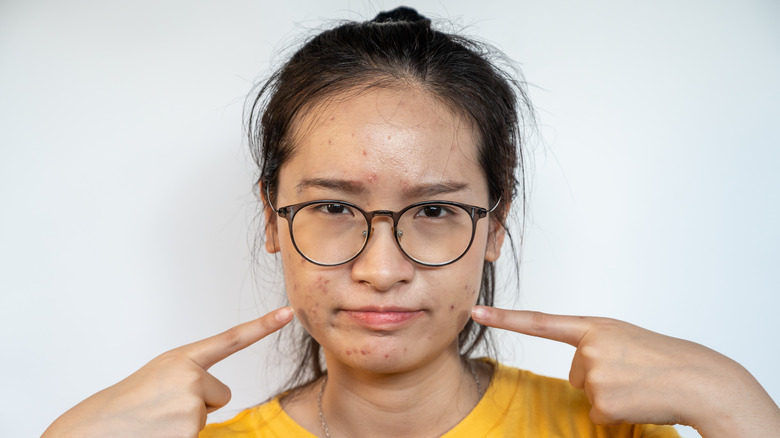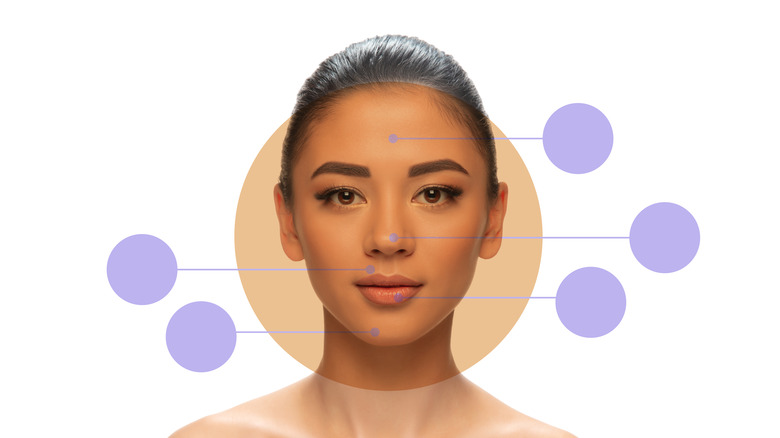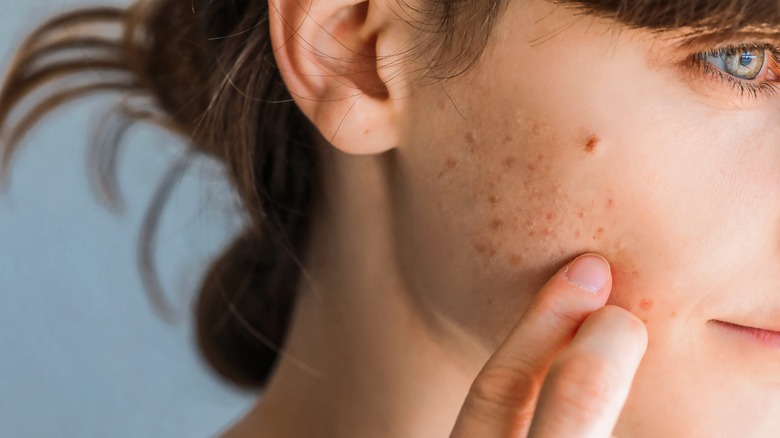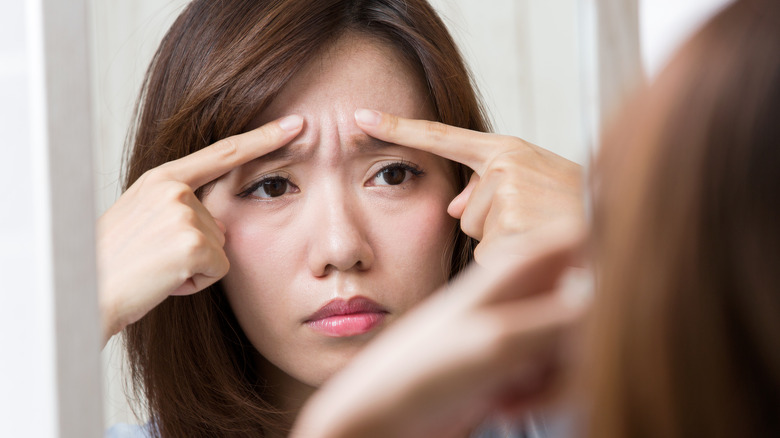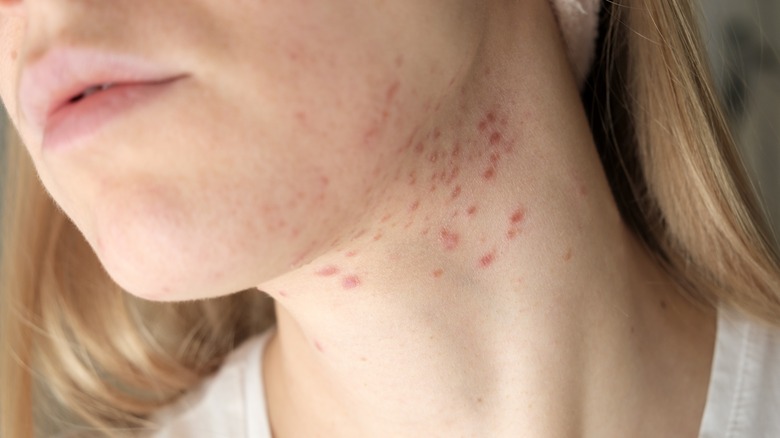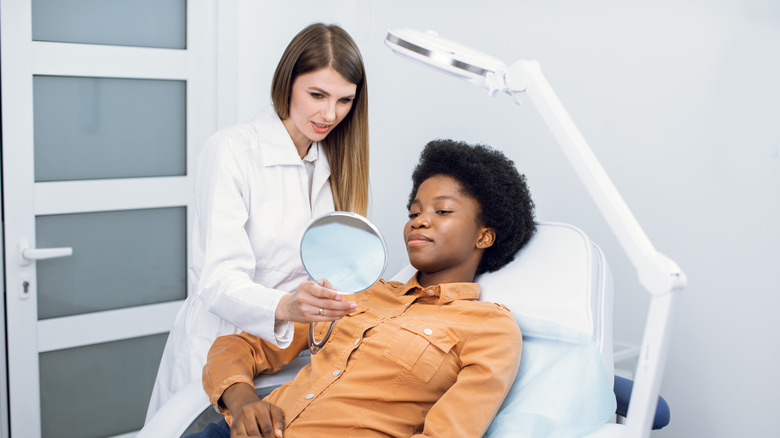Acne Face Mapping: Why Knowing What Type Of Breakout You Have Is Important
Everyone has had a pimple here and there, but for many people, acne is an ongoing problem. According to the American Academy of Dermatology Association, it's also one of the most common skin issues for both teens and adults.
There is so much advice out there for curbing breakouts (which can be incredibly frustrating when you don't ask for it). Yet friends and family often still feel the need to comment on your skin and tell you how eating this or not eating that will whip it into shape. These unwarranted bits of advice not only make gatherings quite uncomfortable, but they are also untrue.
There is no cure-all for acne and breakouts. Each person's body has a unique composition and every case of acne is different. In fact, identifying what specific type of acne you have is part of figuring out how to treat it. One way to recognize what type of acne you have is to look at where it shows up on your face. The process is known as acne face mapping.
How acne face mapping can help
With acne face mapping, the thought is that concentrating on where the breakouts occur helps you identify what parts of your face are prone to breakouts. This information can help you find out what type of acne you have (via Health). It's a pivotal finding because each type of acne requires a specialized treatment plan.
Some causes of acne are hormonal, a prominent cause in teen years but also an acne trigger during adulthood. Other times, breakouts can appear due to certain foods like sugar and oils. Another culprit is makeup
(which can contribute to clogged pores), as well as moisturizers, hair care products, and lotions.
Even overlooked or less-than-stellar hygiene practices can factor into bouts of acne. If you go too long without washing your hair or face, the oil will build and so will bacteria. In warm climates or when working out, sweat can also be a major contributor to developing acne. When paired with wearing tight clothing, it can worsen.
When you break out on your cheeks
Since your cheeks take up a good portion of your face, when breakouts occur here, they can be very troublesome and difficult to conceal. Often, the cause of breakouts in your cheeks can be a result of what they are coming into contact with, such as the makeup you use on your face, and also things your cheeks touch on a daily basis.
Dirty pillowcases, sheets, and blankets can introduce bacteria and dirt into your pores. The same goes for headsets and phones. Dermatologist Amanda Doyle tells Health, "Our cell phones are notorious for carrying germs, and the screen accumulates oil and makeup from pressing against our face."
In addition, Doyle says that sugar consumption can often result in acne on the cheeks. Sugar is often responsible for fluctuations in blood sugar levels, which is another cause of acne on the cheeks. The best eating plan is balanced, filled with veggies, fruit, protein, and whole grain, and doesn't cause high or low blood sugar crashes.
The dreaded T zone
One of the most frustrating and difficult-to-contain places to break out is the T zone. This is the area that essentially forms a T on your face (the forehead, nose, and chin). These are the parts of your face where the most oil is produced and also where blackheads are common. It's also an area that gets affected by hair care products and makeup.
The key to curbing blackheads and pimples in the T zone is to tame oil production. Wash your face at least twice a day. You can also try using oil blotting sheets to absorb oil when on the run. Another way to keep the area clean and unclogged is to use pore strips and exfoliate on a regular basis. Choose a gentle exfoliator that won't dry out the skin.
Since cosmetics come into play here, choose oil-free makeup that is water-based, and make sure you completely cleanse your face at night before going to bed.
What acne along the jawline means
Some people tend to break out all at the bottom of their face, along the jawline. According to Everyday Health, hormonal acne often appears on the lower third of the face, so it is most pronounced along the jawline and can even be found on the neck.
"Hormonal acne tends to live in the lower part of the face — the chin, jawline, and neck — and it tends to be more cystic rather than little blackheads or whiteheads," says dermatologist Dr. Amy Wechsler. This accounts for all hormonal acne, not just the acne that flares up during puberty. It's common for women to break out during PMS and when they are pregnant. Pimples also tend to creep up in the years during perimenopause and menopause.
Wechsler also points out, "The number one reason someone has acne is because of genetics." So while we can do several lifestyle improvements to curb acne, there may be no way to avoid it entirely if it runs in your family.
Cystic acne needs medical treatment
Whiteheads, blackheads, and regular pimples can often be treated by lifestyle modifications such as cleansing the face regularly, as well as cleaning anything that it comes into contact with like pillows and sheets. It also helps to consume a healthy diet and stay away from high glycemic meals that are laden with sugar and oils. Get enough sleep and avoid oil-based makeup. However, none of these adjustments may be enough to help cystic acne.
Cystic acne is often hereditary, as per Cleveland Clinic. It occurs deep within the skin, not on the surface like blackheads and whiteheads. It causes deep and often painful cysts and typically requires more intense treatment. Treatment includes prescription topical antibiotic creams, oral medications, and birth control. Corticosteroid injections sometimes help, but it may also be necessary to get very large cysts drained in a dermatologist's office.
It's always a good idea to see a dermatologist to help with any type of breakouts you're experiencing. A doctor can devise a treatment plan to help heal current issues and prevent future breakouts, especially when you can fill them in on the type of acne you've been having and exactly what parts of your face have been affected.
